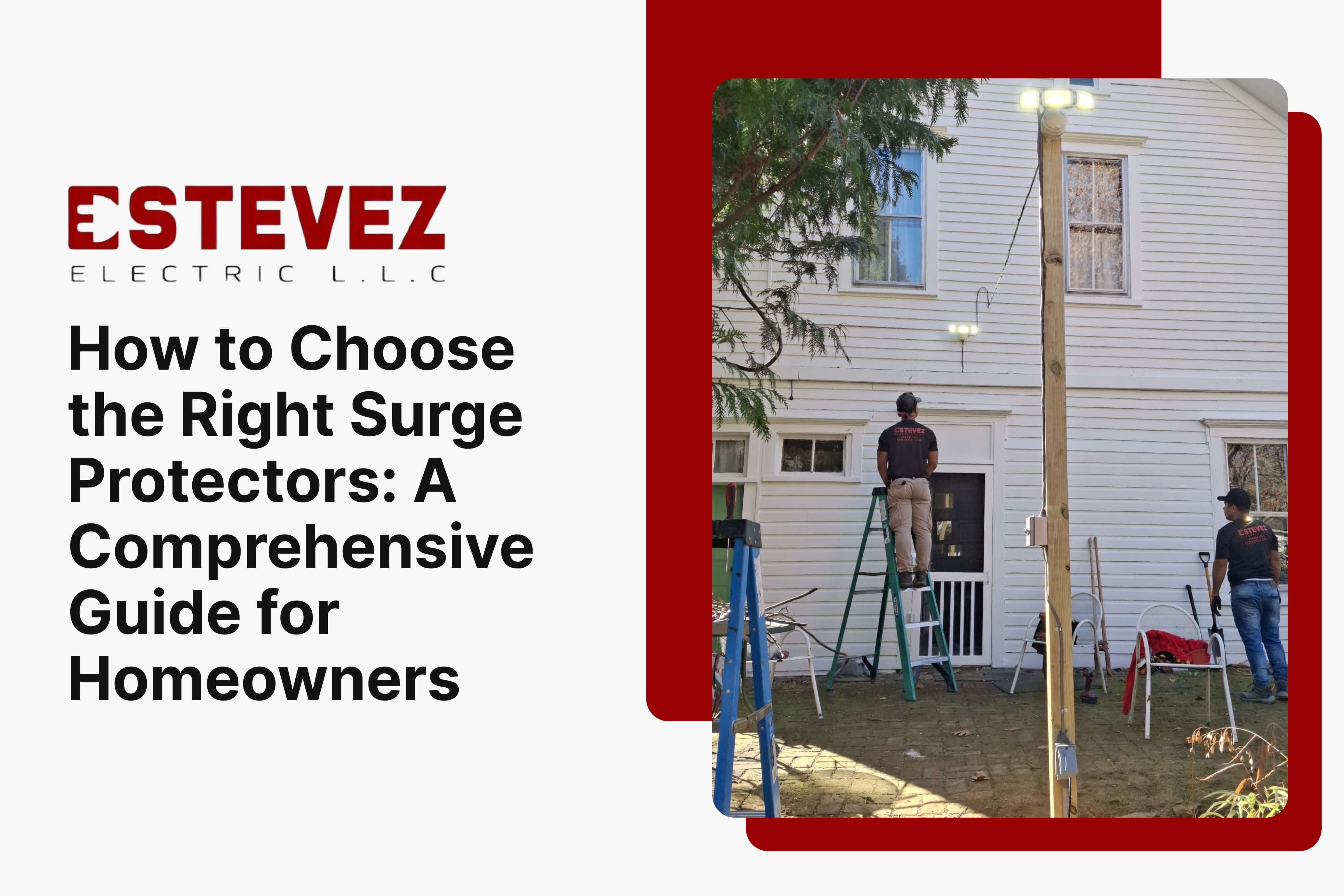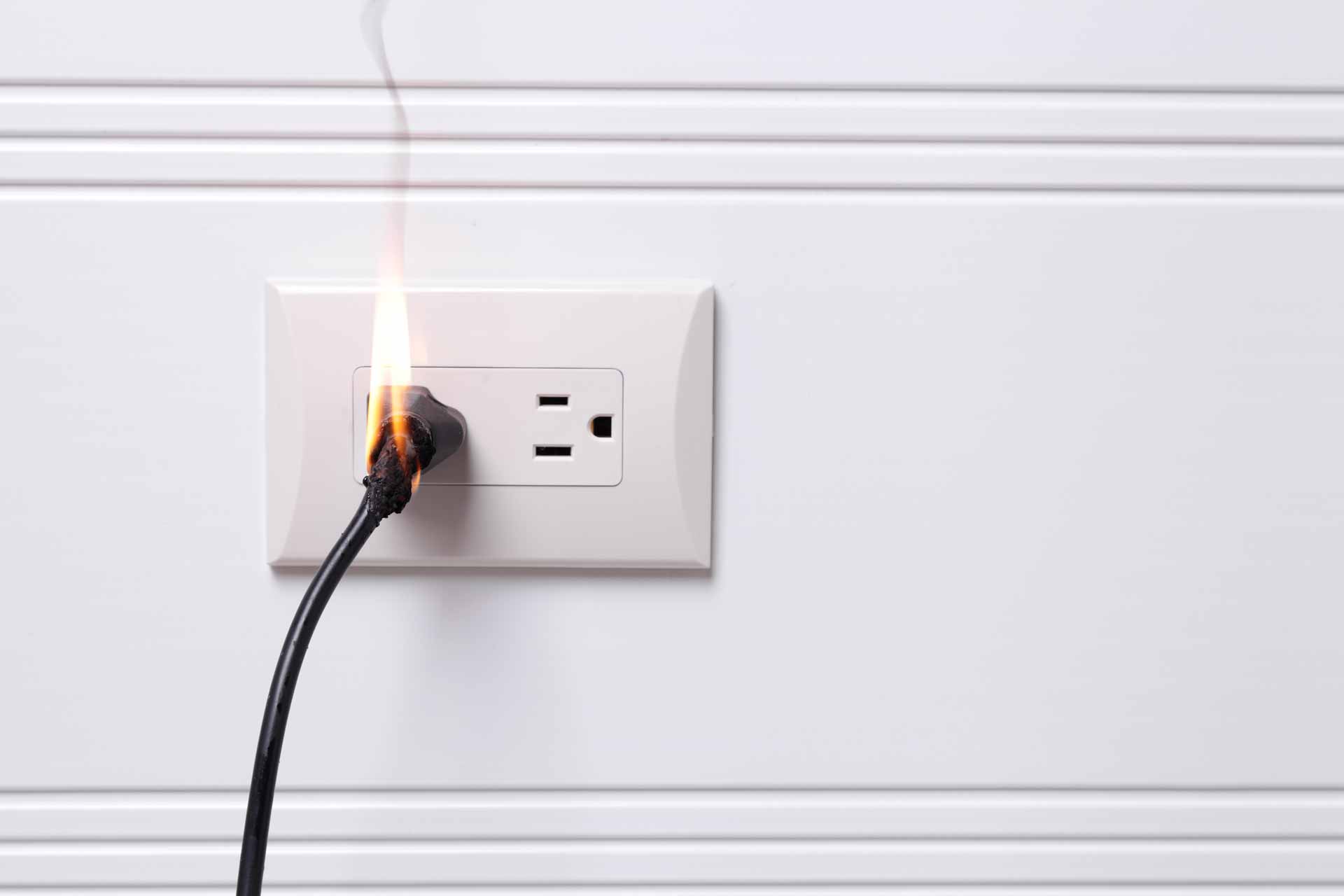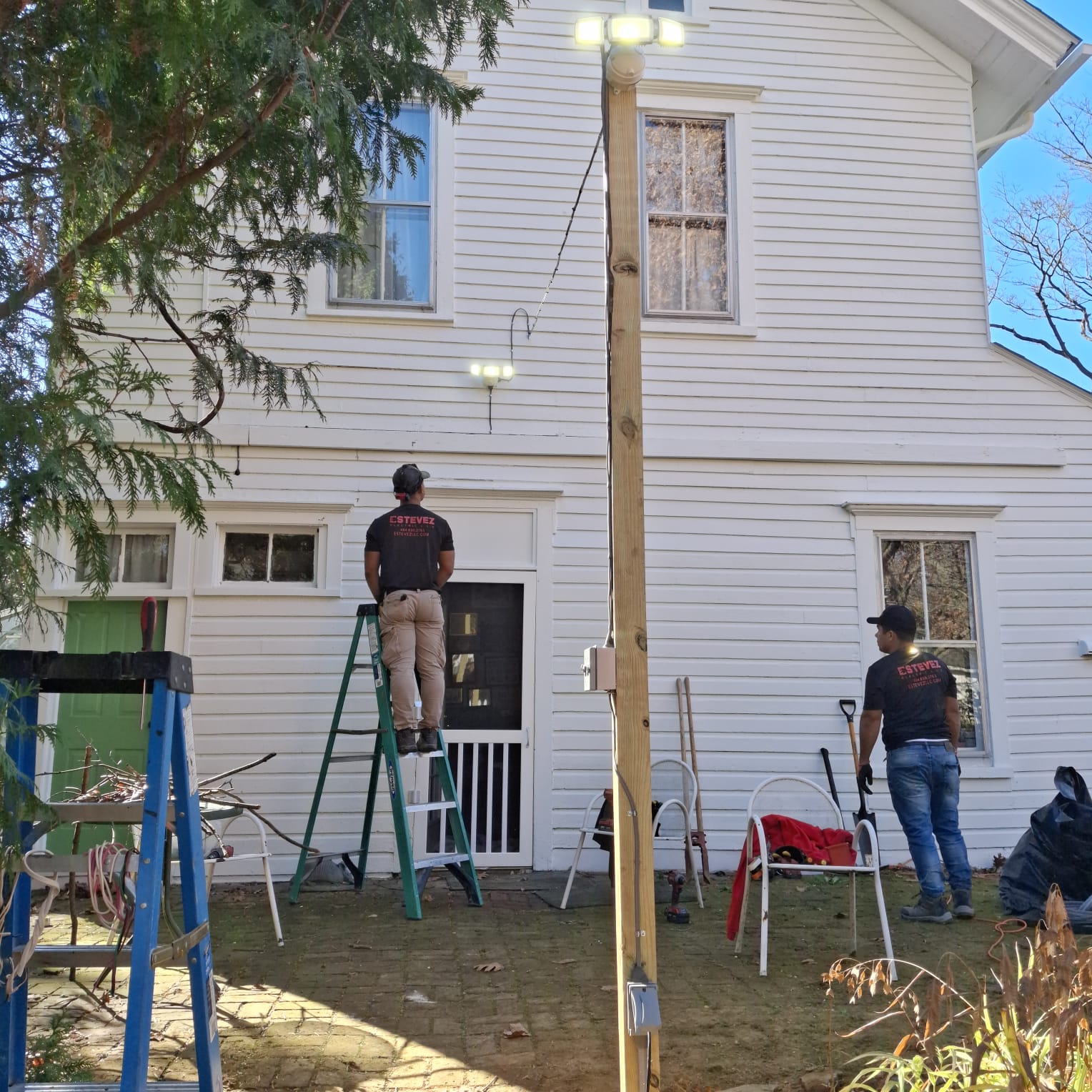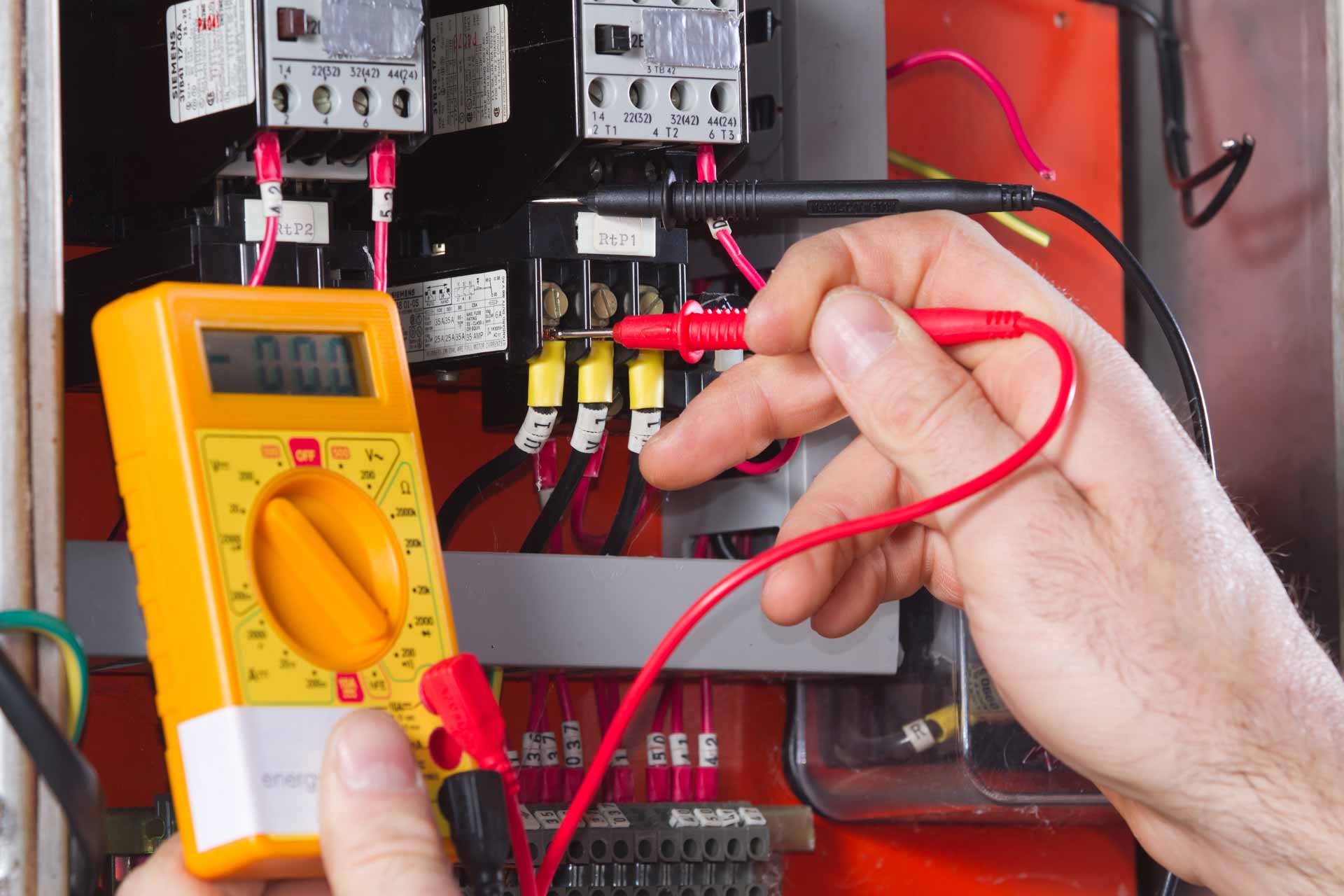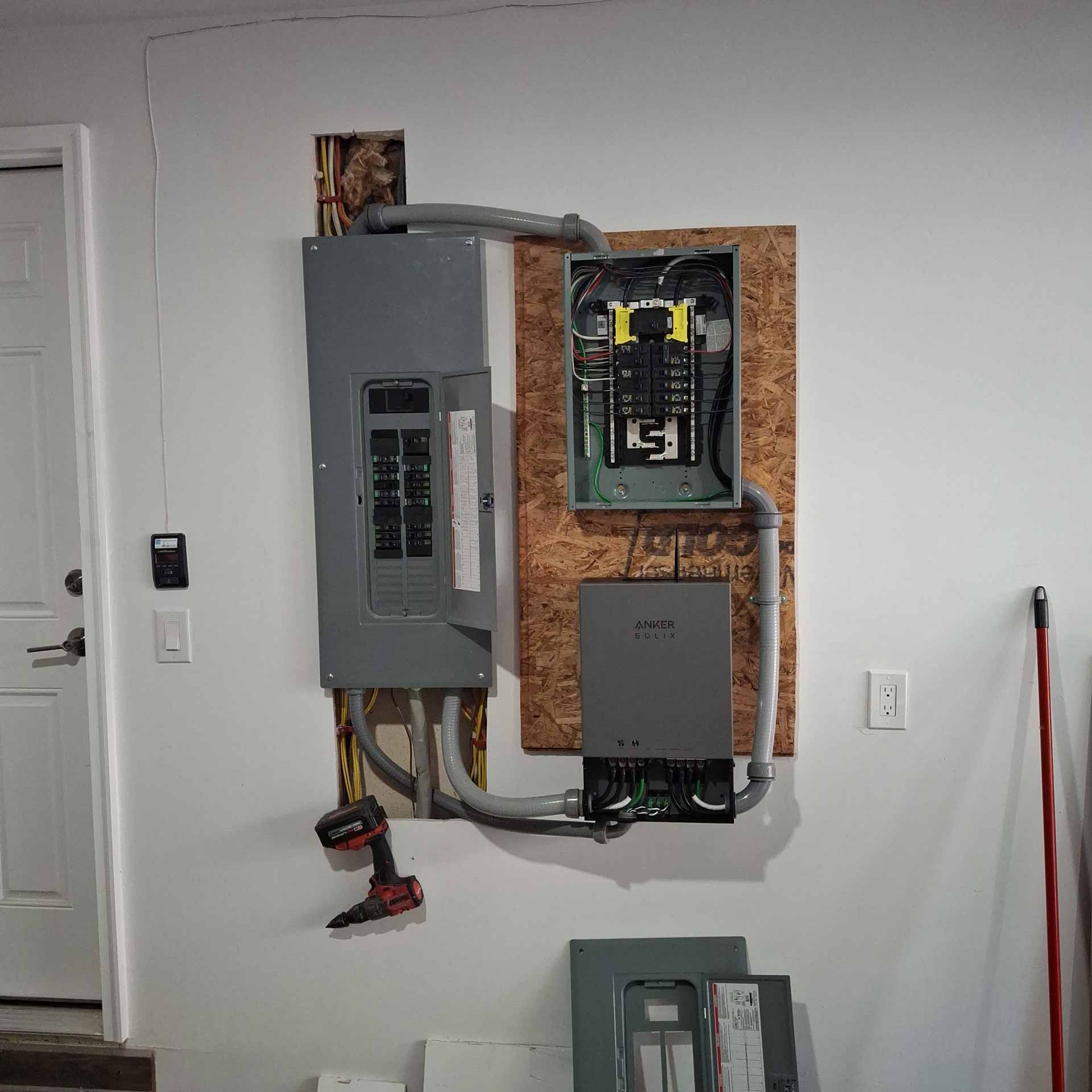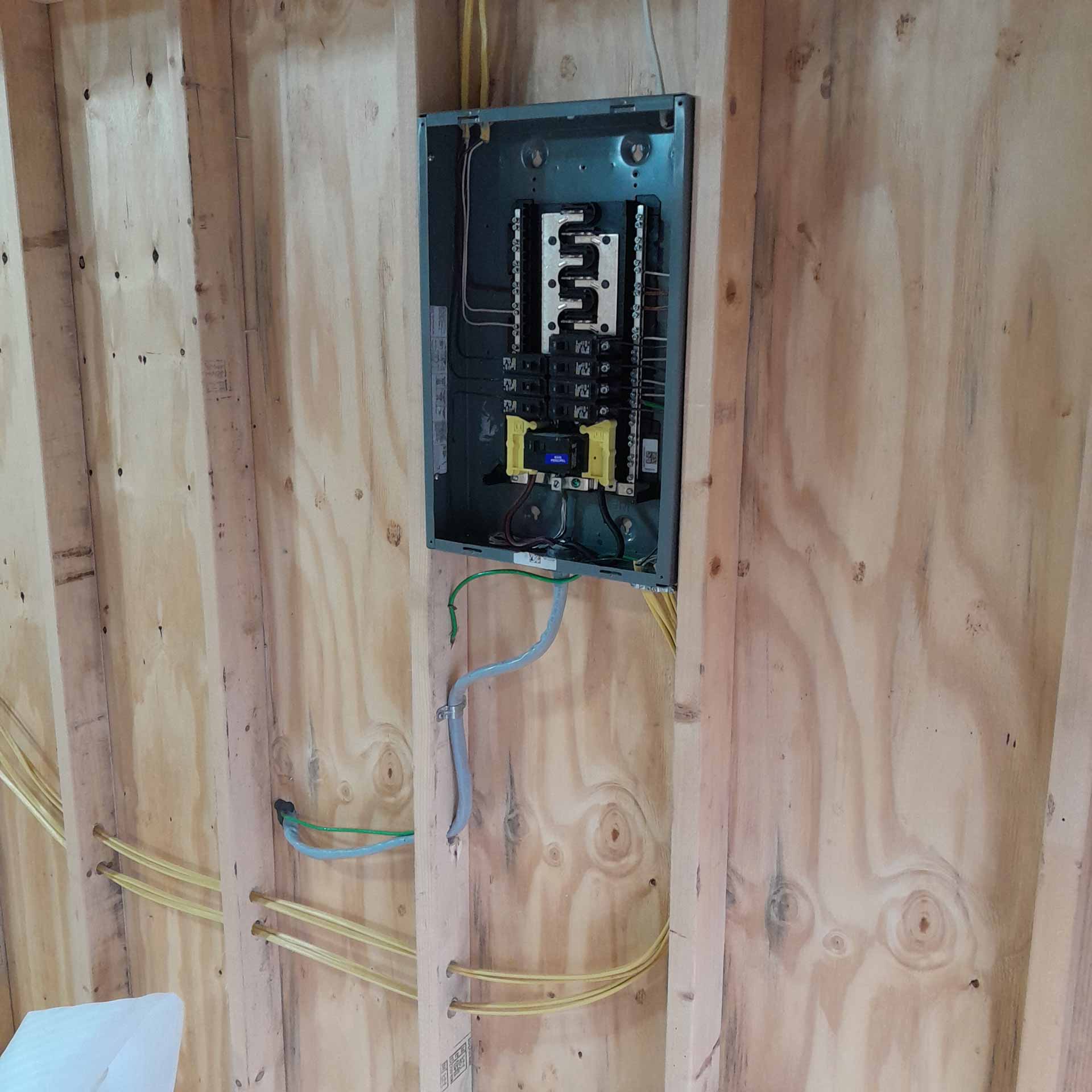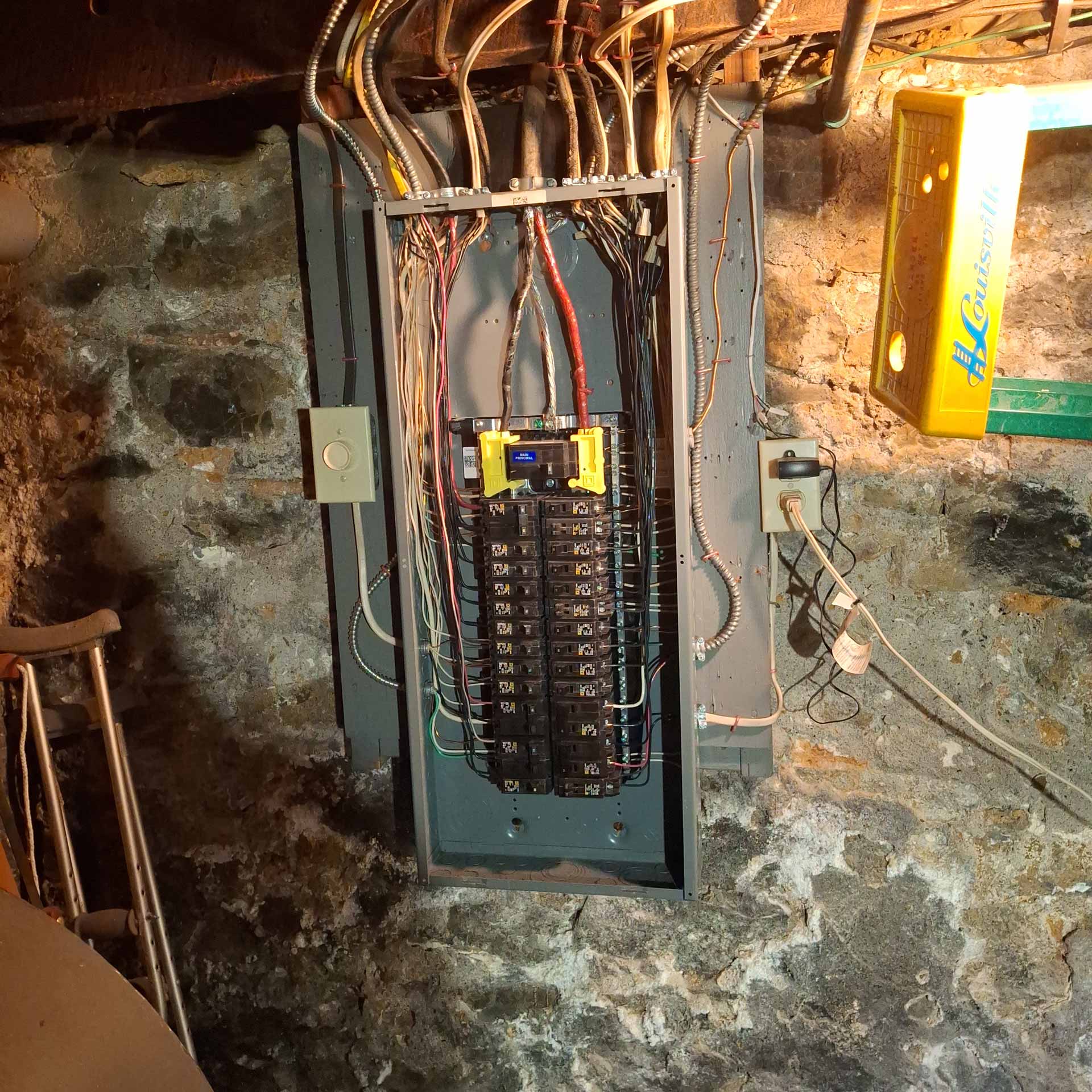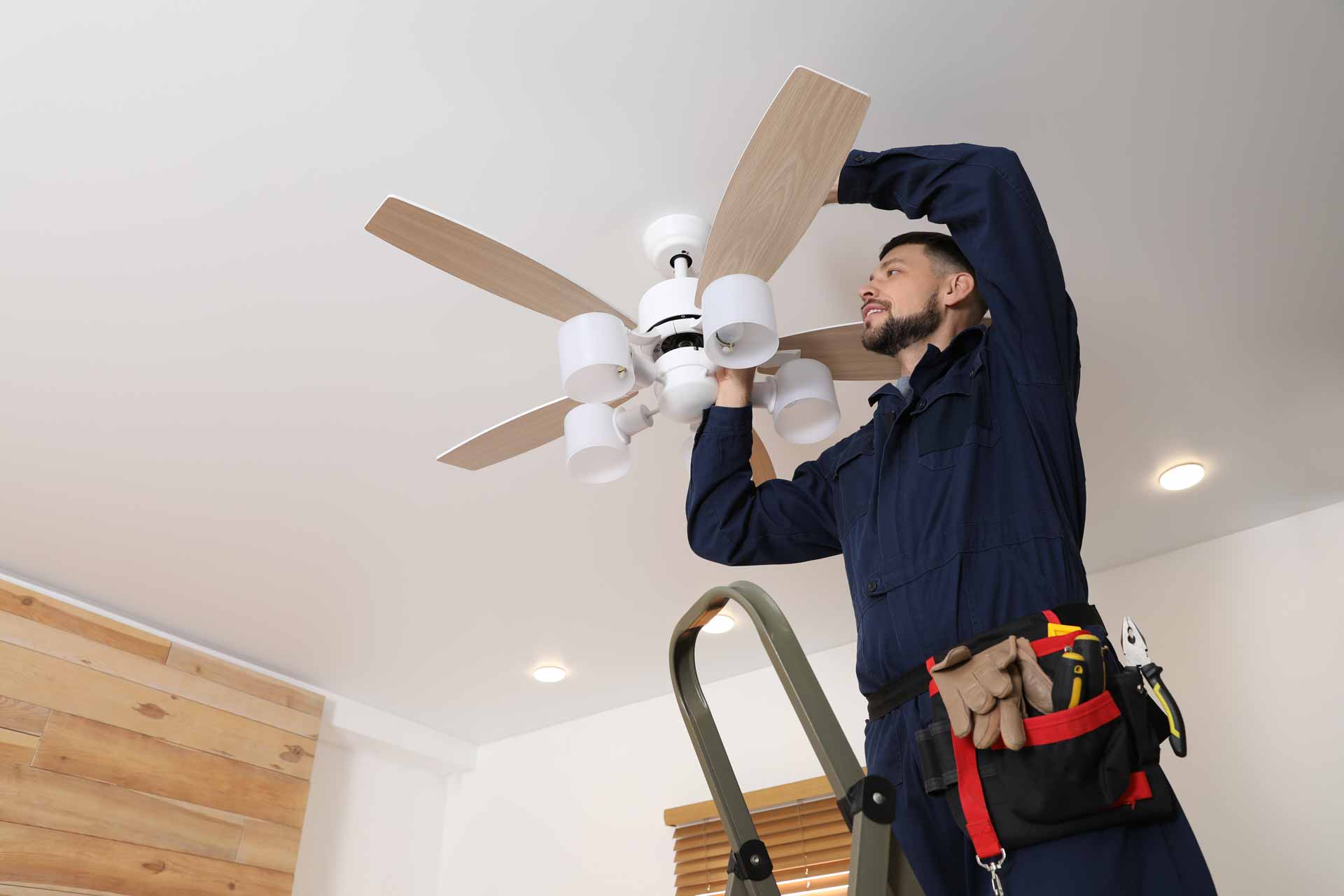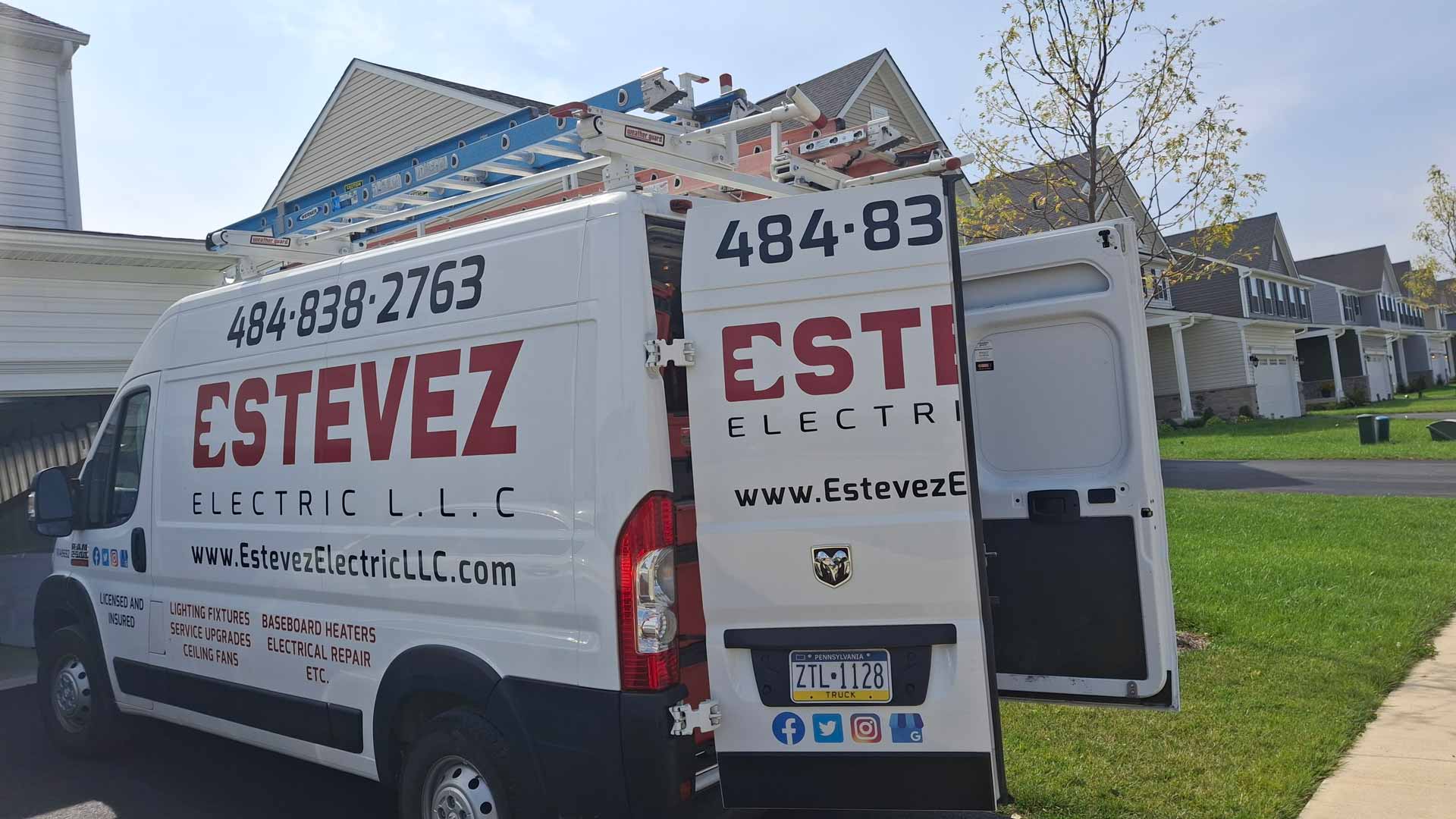Key Takeaways
- Whole-house surge protectors provide comprehensive protection for all electronics in your home
- Joule ratings indicate how much energy a surge protector can absorb before failing
- Professional installation by licensed electricians ensures proper protection and code compliance
- Surge protectors should be replaced every 2-3 years for optimal protection
- Different types of surge protectors serve different needs (point-of-use vs. whole-house protection)
- Investing in quality surge protection can save thousands in potential electronic damage
- A layered approach combining whole-house and point-of-use protection offers maximum security
- Smart homes and specialized equipment like EV chargers require additional protection considerations
- Regular maintenance and inspection of surge protection devices is essential for continued effectiveness
- Power surges come from both external sources (lightning) and internal sources (appliance cycling)
Understanding Surge Protection: Your Home’s First Line of Defense
Power surges represent one of the most common threats to your home’s electrical system and the valuable electronics within it. These sudden voltage spikes can originate from lightning strikes, power grid fluctuations, or even large appliances cycling on and off within your home. Without proper protection, these surges can damage or destroy expensive electronics, from TVs and computers to refrigerators and HVAC systems, often resulting in costly repairs or complete replacement of affected devices.
At Estevez Electric LLC, we understand that many homeowners are unaware of the full extent of damage that power surges can cause. A single major surge can result in thousands of dollars in damage to your electronics and appliances. More concerning, repeated small surges that often go unnoticed can gradually degrade your electronics, shortening their lifespan significantly. These minor surges accumulate over time, causing internal component deterioration that may not be immediately apparent until devices begin to malfunction or fail entirely.
Surge protectors work by diverting excess voltage away from your valuable electronics when a power surge occurs. They act as a barrier between your devices and potentially damaging electrical spikes. When voltage exceeds normal levels, surge protectors redirect the excess electricity into the grounding wire, preventing it from reaching and damaging your connected equipment. However, not all surge protectors are created equal, and choosing the right one requires understanding several key factors including joule ratings, clamping voltage, and response time specifications.
The most effective approach to surge protection involves a layered strategy. Whole-house surge protectors installed at your electrical panel provide your first line of defense, while point-of-use surge protectors offer additional protection for specific devices or areas with sensitive electronics. This comprehensive approach ensures maximum protection against both external surges from lightning or utility problems and internal surges generated by appliances within your home.
Types of Surge Protectors for Residential Use
When it comes to protecting your home from electrical surges, understanding the different types of surge protectors available is crucial for making an informed decision. Each type serves a specific purpose in your overall protection strategy, and knowing their strengths and limitations helps ensure comprehensive coverage for your home’s electrical system.
Whole-House Surge Protectors
Whole-house surge protectors represent the most comprehensive form of protection for your home’s electrical system. These devices are installed directly at your home’s electrical panel by licensed electricians and provide protection for every circuit in your home. This means that all hardwired appliances and electronics plugged into any outlet receive a baseline level of protection against incoming surges from external sources such as lightning strikes or utility grid issues.
The primary advantages of whole-house surge protectors include:
- Complete coverage for all circuits and connected devices throughout your entire home
- Protection from external surges (lightning strikes, utility grid issues) before they can enter your home’s wiring
- Safeguarding for expensive hardwired systems like HVAC, security systems, and kitchen appliances that cannot be connected to point-of-use protectors
- Long-term protection with minimal maintenance requirements
- Single installation point that protects your entire electrical system
Whole-house surge protectors typically have joule ratings ranging from 20,000 to 80,000, indicating their capacity to absorb significant electrical surges. For most residential applications, we recommend models with at least 40,000 joules of protection to ensure adequate safeguarding against major surges. These high-capacity devices can handle multiple surge events over their lifetime, providing continuous protection for your entire electrical system.
Point-of-Use Surge Protectors
While whole-house protection forms your primary defense, point-of-use surge protectors provide an additional layer of security for particularly sensitive or valuable electronics. These are the familiar power strips with surge protection capabilities that most homeowners are already familiar with. They connect directly to wall outlets and provide localized protection for devices plugged into them.
Point-of-use protectors are ideal for:
- Home entertainment systems with expensive components
- Computer workstations with sensitive data storage
- Gaming setups with high-end consoles and accessories
- Home office equipment including printers and networking devices
- Charging stations for multiple devices like phones, tablets, and laptops
When selecting point-of-use surge protectors, look for models with:
- UL 1449 certification (the safety standard for surge protective devices)
- Joule ratings of at least 1,000 (higher is better for valuable electronics)
- Protection indicator lights that show when the surge protection is still functioning
- Auto-shutdown technology that cuts power when protection is compromised
- Adequate spacing between outlets to accommodate bulky adapters and transformers
- Multiple types of protection including coaxial, telephone, or network connections
For optimal protection, we recommend using both whole-house and strategic point-of-use surge protectors for your most valuable electronics. This layered approach provides redundant protection against both external and internal power surges, ensuring maximum security for your devices even if one layer of protection fails or becomes compromised over time.
Key Specifications to Consider When Purchasing Surge Protectors
When evaluating surge protectors for your home, several technical specifications determine how effectively they’ll protect your electronics. Understanding these specifications will help you make an informed decision that provides adequate protection for your specific needs and ensures you’re not underprepared for potential surge events.
Joule Rating: The Measure of Protection Capacity
What is a Joule?
A joule is a unit of energy that, in the context of surge protectors, measures how much energy the device can absorb before it fails. The higher the joule rating, the greater the protection capacity and typically the longer the lifespan of the surge protector.
The joule rating is perhaps the most critical specification to consider when selecting a surge protector. This number indicates the device’s capacity to absorb energy from power surges before it fails and no longer provides protection. Think of it as the “energy absorption capacity” of your surge protector – once this capacity is reached through multiple surges over time, the protection components become compromised and can no longer safeguard your equipment effectively.
For residential applications, we recommend:
- Basic protection: 1,000-2,000 joules (suitable for small electronics like lamps, clock radios, and basic devices)
- Better protection: 2,000-4,000 joules (recommended for computers and entertainment systems with multiple components)
- Premium protection: 4,000+ joules (ideal for high-end electronics, complete home theater setups, and professional equipment)
For whole-house surge protectors, look for significantly higher joule ratings:
- Standard homes: 20,000-40,000 joules (adequate for most residential applications)
- Larger homes or areas with frequent storms: 40,000-80,000 joules (provides extended protection capacity for surge-prone locations)
Remember that once a surge protector has absorbed its maximum joule capacity through multiple surges over time, it will no longer provide protection even though it may continue to supply power to your devices. This “silent failure” makes regular replacement essential for maintaining effective protection.
Clamping Voltage: Response Speed Matters
Clamping voltage indicates the threshold at which the surge protector activates to divert excess voltage away from your equipment. This specification tells you how much voltage will reach your devices before the surge protector begins working. Lower clamping voltage means the surge protector responds more quickly to protect your devices:
- 330V: Excellent protection (responds very quickly, allowing minimal voltage through)
- 400V: Good protection (standard for quality surge protectors)
- 500V or higher: Basic protection (slower response, allows more voltage to pass through)
For sensitive electronics like computers, gaming consoles, and smart TVs, we recommend surge protectors with clamping voltages of 400V or lower. This ensures that your devices are protected before voltage levels reach potentially damaging thresholds. Higher-end equipment with sensitive microprocessors benefits most from the lowest possible clamping voltage ratings.
Response Time: How Quickly Protection Activates
Response time measures how quickly the surge protector reacts to a voltage spike, typically measured in nanoseconds (ns). The faster the response time, the better the protection, as less excess voltage will reach your devices before diversion occurs:
- 1 nanosecond or less: Excellent protection (nearly instantaneous response)
- 1-5 nanoseconds: Good protection (fast enough for most home electronics)
- More than 5 nanoseconds: Basic protection (may allow some surge energy to pass through)
For most home applications, look for surge protectors with response times of 1 nanosecond or less to ensure your electronics receive immediate protection during a surge event. This rapid response is particularly important for protecting devices with sensitive microprocessors and memory components that can be damaged by even brief exposure to excess voltage.
Additional Protection Features Worth Considering
Beyond the core specifications, quality surge protectors often include additional protection features that enhance their effectiveness and provide extra value for your investment:
- EMI/RFI filtering: Reduces electromagnetic and radio frequency interference that can degrade performance of sensitive equipment like audio systems, televisions, and networking devices
- Line conditioning: Smooths out minor power fluctuations for more stable power delivery, extending the life of sensitive components
- Auto-shutdown technology: Automatically cuts power when surge protection is compromised, preventing unprotected operation
- Protected indicator lights: Visual confirmation that surge protection is still functioning, allowing you to identify when replacement is needed
- Connected equipment warranty: Financial protection if your equipment is damaged while properly connected to the surge protector, sometimes covering thousands of dollars in potential damages
- Multiple types of protection: Protection for various connections beyond power, including telephone, coaxial cable, Ethernet, and USB lines
At Estevez Electric, we can help you select and install the right surge protection solutions based on your specific home configuration and electronic protection needs. Our experienced technicians evaluate your entire electrical system to recommend the most effective combination of whole-house and point-of-use protection for your unique situation.
Whole-House Surge Protection: The Comprehensive Solution
While point-of-use surge protectors provide targeted protection for specific devices, whole-house surge protection represents the most comprehensive approach to safeguarding your home’s electrical system. This solution protects not just plugged-in devices, but all of your home’s electrical circuits and hardwired systems, creating a primary defense barrier at your electrical service entrance.
Why Whole-House Protection Is Superior
Whole-house surge protectors offer several advantages that point-of-use devices cannot match, making them an essential component of complete home protection:
- Complete Coverage: Protects every circuit in your home, including hardwired systems like HVAC, security systems, and built-in appliances that can’t be plugged into traditional surge protectors. This comprehensive protection extends to every outlet and connected device throughout your home.
- First Line of Defense: Intercepts external surges (like lightning strikes and utility grid fluctuations) before they enter your home’s electrical system, preventing them from reaching any of your devices. This primary barrier stops damaging surges at the entry point before they can spread throughout your home’s wiring.
- Extended Equipment Lifespan: By preventing both major surges and the cumulative damage from smaller, more frequent surges, whole-house protection helps extend the life of all your electrical equipment. This preservation of equipment functionality translates to significant long-term savings on replacement costs.
- Convenience: Once installed, requires no management of multiple point-of-use devices throughout your home. There’s no need to worry about having enough outlets or replacing multiple units as they age – the centralized protection works silently in the background.
- Property Value: Represents a permanent improvement to your home’s electrical system that can increase property value and appeal to potential buyers who understand the importance of comprehensive electrical protection.
Professional Installation: A Critical Requirement
Professional installation by licensed electricians is essential for whole-house surge protection. These systems must be properly integrated with your electrical panel and correctly grounded to function effectively. Improper installation can lead to inadequate protection or even create safety hazards within your electrical system.
Our team at Estevez Electric is fully licensed, bonded, and insured to perform these installations safely and in compliance with all electrical codes. We bring specialized knowledge of surge protection requirements and extensive experience with various electrical panel configurations to ensure optimal installation results.
The installation process typically involves:
- Evaluating your electrical panel to ensure compatibility with whole-house surge protection devices
- Selecting the appropriate surge protection device for your home’s size and needs
- Installing the device directly at the electrical panel with proper connections and secure mounting
- Ensuring proper grounding for effective surge diversion
- Testing the system to confirm proper operation under various conditions
- Providing documentation and warranty information for future reference
Cost vs. Value Consideration
While whole-house surge protection represents a larger initial investment than point-of-use solutions, the comprehensive protection it provides offers exceptional value when considering the potential costs of surge damage:
- Initial Investment: Typically ranges from $300-$700 for equipment and professional installation
- Potential Savings: Protects thousands of dollars worth of electronics and appliances throughout your entire home
- Longevity: Quality whole-house surge protectors last 5-10 years with minimal maintenance requirements
- Peace of Mind: Continuous protection against both external and internal surge events, regardless of where they originate
When you consider that a single major surge can damage multiple expensive devices simultaneously, the investment in whole-house protection quickly pays for itself. A comprehensive surge event affecting multiple systems could potentially cause $5,000-$10,000 in damage to electronics, appliances, and systems throughout your home – far exceeding the cost of installation.
Additionally, many homeowners insurance policies offer discounts for homes with professionally installed whole-house surge protection systems, recognizing the reduced risk of electrical damage claims. These discounts can further offset the initial investment over time.
Contact Estevez Electric for a consultation on whole-house surge protection options tailored to your specific home configuration and protection needs. Our experts can evaluate your current electrical system and recommend the most appropriate solution based on your home’s size, location, and the value of electronics requiring protection.
The Hidden Dangers of Inadequate Surge Protection
Many homeowners underestimate the frequency and potential damage of power surges, often believing that surge events only occur during dramatic thunderstorms. This misconception leaves homes vulnerable to both catastrophic surge damage and the more insidious effects of repeated minor surges that gradually degrade electronic components over time.
Common Sources of Power Surges
Power surges can originate from multiple sources, both external and internal to your home, making comprehensive protection essential for complete security:
- Lightning Strikes: The most dramatic and potentially destructive source, capable of sending thousands of volts through your electrical system in an instant. Even lightning strikes that occur some distance from your home can travel through utility lines and enter your electrical system, causing widespread damage to connected devices.
- Utility Grid Issues: Power outages, grid switching, and restoration of service after outages can all create significant surges. When power is restored after an outage, the sudden rush of electricity can create voltage spikes that damage unprotected equipment. Additionally, routine maintenance on the power grid can cause fluctuations that affect residential systems.
- Internal Equipment Cycling: Large appliances with motors or compressors (refrigerators, air conditioners, pumps, etc.) create small surges when cycling on and off. These devices require extra power when starting up, which can cause minor voltage fluctuations throughout your home’s electrical system. While individual events may be small, their cumulative effect over time can be significant.
- Electrical Accidents: Damaged power lines or transformer issues in your neighborhood can send surges through multiple homes. Construction accidents, vehicle collisions with utility poles, or equipment failures at local substations can all introduce unexpected surges into residential electrical systems.
- Overloaded Circuits: Too many devices on a single circuit can create unstable power conditions that damage electronics over time. These overloads cause voltage fluctuations that, while not as dramatic as lightning strikes, can gradually degrade sensitive electronic components.
The Cumulative Damage of Small Surges
While catastrophic surges from lightning strikes get the most attention, the cumulative effect of smaller, more frequent surges often causes more total damage over time:
- These minor surges gradually degrade electronic components by subjecting them to voltage levels beyond their design specifications
- They reduce the lifespan of expensive devices by months or years through incremental damage to internal circuitry
- The damage is often attributed to “premature failure” rather than power issues, masking the true cause of equipment problems
- Homeowners replace devices without addressing the underlying cause, creating a cycle of unnecessary expenses
Modern electronics are particularly vulnerable to these effects because they contain increasingly sensitive microprocessors and components that operate at lower voltages. As devices become more sophisticated, they often become more susceptible to damage from even minor power fluctuations.
Did You Know?
The average home experiences hundreds of minor power surges each year, most of which go completely unnoticed until devices begin failing prematurely. These small surges may only last microseconds but can gradually deteriorate electronic components over time.
The Financial Impact of Surge Damage
The cost of inadequate surge protection extends far beyond the price of a single damaged device, potentially affecting your entire home’s electrical ecosystem:
- Replacement Costs: Modern homes contain thousands of dollars worth of vulnerable electronics, from entertainment systems and computers to smart appliances and home automation equipment. A comprehensive surge event could necessitate replacing multiple expensive devices simultaneously.
- Data Loss: Damaged computers and storage devices can result in irreplaceable lost data, including family photos, financial records, and important documents. The value of this lost information often far exceeds the cost of the hardware itself.
- Business Disruption: For those working from home, equipment damage can impact livelihood and result in lost income or productivity. Remote workers rely on functioning electronics for their employment, making protection particularly crucial.
- Hidden Damage: Some surge effects don’t cause immediate failure but significantly shorten device lifespan, leading to unexpected replacements and increased long-term ownership costs. This gradual degradation can affect multiple devices throughout your home simultaneously.
Proper electrical safety devices, including quality surge protection, represent one of the most cost-effective insurance policies you can purchase for your home’s electrical system and the valuable devices connected to it. The investment in comprehensive protection typically pays for itself many times over through extended equipment life and avoided replacement costs.
Strategic Placement of Surge Protectors in Your Home
Knowing where to place surge protectors throughout your home is just as important as selecting the right type. Strategic placement ensures comprehensive protection for all your valuable electronics while addressing areas with higher surge vulnerability or concentration of expensive equipment.
High-Priority Areas for Surge Protection
- Home Entertainment Centers: Modern entertainment systems often represent thousands of dollars in investment and contain sensitive electronics that process complex audio and video signals. Use a surge protector with enough outlets for all components and adequate joule rating (3,000+ joules recommended) to protect televisions, sound systems, gaming consoles, streaming devices, and other components. Look for models that also protect coaxial cable and HDMI connections, as surges can travel through these pathways as well.
- Home Office Setups: Computers, printers, external drives, and networking equipment are particularly vulnerable to surge damage due to their sensitive microprocessors and data storage components. Look for surge protectors with dedicated outlets for data lines (phone, Ethernet) in addition to power protection to prevent surges from entering through communication lines. Consider models with higher joule ratings (2,500+ joules) and EMI/RFI filtering for equipment that processes or stores important data.
- Kitchen Appliances: Today’s smart refrigerators, dishwashers, and other kitchen appliances contain sensitive electronics that control their operations. While large appliances should ideally be protected by whole-house systems, point-of-use protection can be added for additional security. Special consideration should be given to expensive smart appliances with digital displays and internet connectivity features that may be particularly vulnerable to surge damage.
- Charging Stations: Areas where multiple devices charge (phones, tablets, laptops) benefit from surge protectors with USB ports and adequate spacing between outlets. These locations often contain numerous expensive portable devices simultaneously, making them high-value protection points. Look for models specifically designed for charging multiple devices with appropriate spacing and dedicated charging ports.
- Smart Home Hubs: Central locations for smart home controllers, hubs, and bridges should have dedicated surge protection to maintain your home automation systems during power events. These devices often control multiple systems throughout your home, making their protection particularly important for maintaining overall functionality.
Creating Zones of Protection
For comprehensive coverage, consider dividing your home into protection zones that address different potential surge entry points and provide layered defense:
- Zone 1: Main electrical panel with whole-house surge protection, serving as your primary defense against external surges entering through power lines
- Zone 2: Point-of-entry protection for cable, satellite, and telephone lines, which can carry surges into your home through communication pathways rather than electrical lines
- Zone 3: Point-of-use protection for specific devices and areas containing valuable or sensitive equipment
This layered approach provides redundant protection against surges that might bypass a single layer of defense. For example, a surge entering through a cable line would be stopped by Zone 2 protection even if it bypassed your electrical panel protection.
Special Considerations for Modern Homes
Modern homes present unique surge protection challenges due to the proliferation of connected devices and specialized equipment that may have specific protection requirements:
- EV Charging Stations: Electric vehicle charging equipment represents both a significant investment and a potential source of internal surges. These should be protected by dedicated, high-capacity surge protection designed specifically for high-current applications. EV chargers typically operate at higher amperages than standard household equipment, requiring specialized protection components.
- Smart Home Systems: Integrated home automation systems often connect throughout the house using various communication protocols. Protecting central hubs is essential, but distributed components may also need protection, particularly those controlling critical systems like security, HVAC, or lighting. Consider how these systems interconnect when planning your protection strategy.
- Home Offices: With more people working from home, protecting business equipment has become increasingly important. Consider UPS (uninterruptible power supply) devices with built-in surge protection for critical work equipment to provide both surge protection and continuous power during outages. This dual protection prevents both physical damage and data loss during power events.
- Outdoor Electronics: Outdoor lighting systems, security cameras, and entertainment systems need weather-resistant surge protection rated for outdoor use. These devices are often at higher risk due to their proximity to potential lightning strikes and exposure to the elements. Look for surge protectors specifically designed and rated for outdoor installation.
Professional Tip
For homes with extensive electronics or those in areas prone to lightning strikes, consider a comprehensive protection plan that includes both whole-home and strategic point-of-use protection. Our team at Estevez Electric can help design a custom protection strategy for your specific needs, addressing unique features of your home’s layout and electrical system.
When to Replace Your Surge Protectors
Even the highest quality surge protectors have a limited lifespan. Understanding when to replace these devices is crucial for maintaining effective protection for your valuable electronics, as surge protectors that have exceeded their capacity provide a false sense of security while offering no actual protection.
Lifespan Indicators for Surge Protectors
Surge protectors wear out over time as they absorb power surges. Unlike most electronic devices, which show obvious signs of failure, surge protectors can continue providing power even after their protective components have been compromised. This “silent failure” makes regular assessment and replacement particularly important for maintaining effective protection. Here are key indicators that it’s time for replacement:
- Age: Most quality surge protectors have a lifespan of 3-5 years under normal conditions. This timeframe can be shorter in areas with frequent electrical storms or power grid issues. If you can’t remember when you purchased your surge protector, it’s probably time to replace it regardless of apparent functionality.
- Protection Indicator Light: Many surge protectors include an indicator light that shows when surge protection is active. If this light is no longer illuminated (while the power is still working), the protection components have likely failed and the device is now functioning merely as a power strip without protective capabilities.
- After Major Surge Events: If your home has experienced a significant power surge or lightning strike nearby, inspect all surge protectors for signs of damage or failure, even if they appear to be working normally. Major surge events can significantly deplete or completely exhaust a surge protector’s capacity, necessitating immediate replacement.
- Physical Damage: Any visible damage to the surge protector, including scorch marks, melted plastic, or unusual odors, indicates immediate replacement is necessary. These physical signs suggest the device has already experienced a significant surge event that may have compromised its protective capabilities.
- Repeated Reset Requirements: If the surge protector’s circuit breaker trips frequently, this may indicate internal damage or that you’re exceeding its capacity. Either situation requires assessment and likely replacement to ensure adequate protection for connected devices.
Whole-House Surge Protector Maintenance
Whole-house surge protectors typically have a longer lifespan than point-of-use models but still require periodic inspection and eventual replacement to maintain effective protection:
- Have your whole-house surge protection device inspected annually by a licensed electrician who can assess its condition and functionality
- Check indicator lights monthly to ensure protection is still active and the device hasn’t silently failed
- Replace according to manufacturer recommendations (typically 5-10 years) even if the device appears to be functioning properly
- Consider replacement after significant surge events regardless of age, as major surges can significantly deplete protection capacity
- Keep records of installation dates and scheduled maintenance to ensure timely replacement
Replacement Schedule Tip
Create a reminder in your calendar or home maintenance schedule to check and potentially replace surge protectors every 3-5 years. Mark the purchase date on the device with a permanent marker to help track its age. This simple practice ensures you don’t lose track of when protection devices were installed and helps maintain continuous protection for your valuable electronics.
Signs Your Surge Protector May No Longer Be Effective
Even if a surge protector appears to be working, several subtle signs may indicate it’s no longer providing adequate protection for your connected devices:
- Flickering or dimming lights when devices turn on or off while connected to the surge protector, suggesting the device is no longer regulating power effectively
- Intermittent device operation or unexplained reboots of connected equipment, which may indicate power fluctuations are reaching your devices despite the surge protector
- Unusual noises coming from the surge protector, such as buzzing or clicking, which often signal internal component degradation or failure
- Hot spots on the surge protector housing, indicating potential internal damage or component failure that could present both protection and safety issues
- Tripped breakers or blown fuses elsewhere in your home’s electrical system when using devices connected to the surge protector, suggesting it’s no longer properly managing electrical flow
At Estevez Electric, we recommend a proactive approach to surge protector replacement rather than waiting for signs of failure. The cost of replacement is minimal compared to the potential damage to your valuable electronics. Regular replacement according to manufacturer guidelines ensures continuous protection and peace of mind knowing your devices are properly safeguarded against unpredictable power events.
Common Surge Protector Myths and Misconceptions
Many homeowners operate under misconceptions about surge protectors that can leave their electronics vulnerable. Let’s address some of the most common myths to ensure you’re making informed decisions about protecting your home and valuable devices.
Myth 1: All Power Strips Provide Surge Protection
Reality: Power strips and surge protectors are not the same thing. Many power strips simply provide additional outlets without any surge protection capabilities. A basic power strip merely extends your electrical outlet capacity without offering any defense against power surges or voltage spikes. Always look for devices specifically labeled as surge protectors with a joule rating clearly indicated. Without this specification, you’re likely using a simple power strip that offers no protection whatsoever for your connected equipment.
Myth 2: Surge Protectors Last Forever
Reality: Surge protectors have a limited lifespan. They contain components (typically metal oxide varistors or MOVs) that sacrifice themselves to absorb energy from surges. Once these components have absorbed their maximum capacity (measured in joules), they no longer provide protection even though they continue to supply power. This creates a dangerous situation where homeowners believe their devices are protected when they actually have no surge protection at all. Regular replacement is essential for maintaining effective protection.
Myth 3: One Surge Protector Is Enough for the Whole House
Reality: While whole-house surge protectors provide excellent first-line defense, they’re most effective when complemented by point-of-use surge protectors for sensitive electronics. A layered approach provides the most comprehensive protection. Whole-house protectors handle large external surges, while point-of-use devices provide additional protection against smaller internal surges and offer redundancy in case the primary protection fails. The most effective strategy combines both types for maximum security.
Myth 4: Unplugging Devices During Storms Provides Complete Protection
Reality: While unplugging devices during storms is a good practice, it doesn’t address the many other sources of power surges, including those generated internally by appliances or external utility issues that occur without warning. Surges can happen at any time, not just during visible storms, and often occur when power is restored after an outage. Comprehensive surge protection provides continuous defense against all types of surges, regardless of their source or timing.
Myth 5: Expensive Electronics Have Built-in Surge Protection
Reality: While some high-end electronics have limited internal surge protection, this is typically designed to handle only minor fluctuations. These internal protections are not sufficient to guard against significant power surges and should not be relied upon as your only line of defense. Internal protection components are generally designed to handle normal operating conditions, not the extreme voltage spikes that can occur during major surge events. External surge protection remains essential for valuable electronics regardless of their price point or built-in features.
Warning
Never “daisy-chain” surge protectors by plugging one into another. This practice can create fire hazards and doesn’t provide additional protection. Each surge protector should be plugged directly into a wall outlet to ensure proper grounding and functionality. Daisy-chaining can overload circuits and potentially defeat safety mechanisms designed to protect your home.
Myth 6: Surge Protectors and UPS Devices Serve the Same Purpose
Reality: While both devices may offer some surge protection, they serve different primary functions and are designed for distinct purposes:
- Surge Protectors: Designed specifically to protect against voltage spikes by diverting excess electricity away from connected devices
- UPS (Uninterruptible Power Supply): Primarily designed to provide backup power during outages, with surge protection as a secondary feature
For critical equipment that needs both continuous power and surge protection, consider using both a quality UPS and a surge protector in tandem. This combination provides comprehensive protection against both power interruptions and voltage fluctuations, ensuring maximum safety for your most important devices.
Myth 7: Lightning Protection Is Guaranteed
Reality: No surge protector can provide 100% protection against a direct lightning strike. Lightning can deliver hundreds of thousands of volts, far exceeding the capacity of even the best surge protection devices. Whole-house surge protectors significantly improve your odds of avoiding damage from nearby strikes, but for areas with frequent severe lightning, additional measures like lightning rods may be necessary to complement surge protection. A comprehensive approach to lightning protection involves multiple systems working together rather than relying solely on surge protectors.
At Estevez Electric, we provide honest, factual information about what surge protection can and cannot do, helping you make informed decisions about protecting your home’s electrical system and connected devices. Understanding the limitations of surge protection technology allows you to implement more effective strategies for safeguarding your valuable electronics against various types of electrical threats.
DIY vs. Professional Installation: What You Need to Know
When it comes to surge protection, understanding which components you can safely install yourself and which require professional installation is crucial for both safety and effectiveness. Making the right choice ensures your protection system functions properly while avoiding potential hazards associated with electrical work.
Point-of-Use Surge Protectors: Suitable for DIY Installation
Standard point-of-use surge protectors that plug into wall outlets are designed for DIY installation. These consumer-grade devices require no special tools or expertise to implement and can be safely installed by homeowners. When installing these devices yourself:
- Choose the Right Rating: Select surge protectors with appropriate joule ratings for the devices you’ll be connecting. More expensive or sensitive equipment warrants higher joule ratings for better protection against power fluctuations.
- Avoid Overloading: Never exceed the amperage rating of the surge protector. Check the combined power requirements of all connected devices to ensure they remain within the surge protector’s capacity limits. Overloading can defeat protection mechanisms and create fire hazards.
- Proper Placement: Keep surge protectors away from heat sources and moisture. Install them in well-ventilated areas where air can circulate freely around the device to prevent overheating during operation.
- Secure Connections: Ensure all plugs are fully inserted into the surge protector. Loose connections can create resistance that generates heat and potentially damages both the surge protector and connected devices.
- Avoid Extension Cords: Connect surge protectors directly to wall outlets when possible. Using extension cords between the wall outlet and surge protector can compromise grounding and reduce protection effectiveness.
These simple precautions will help ensure your point-of-use surge protectors function effectively and safely, providing reliable protection for your connected devices without creating additional hazards in your home.
Whole-House Surge Protection: Professional Installation Required
Whole-house surge protectors should always be installed by licensed electricians for several important reasons that involve both safety and effectiveness considerations:
- Electrical Panel Work: Installation requires working inside your main electrical panel, which contains dangerous voltage levels that can cause serious injury or death. Licensed electricians have the training, tools, and safety equipment to perform this work without risk.
- Code Compliance: Professional installation ensures the system meets all local electrical codes and safety requirements. Non-compliant installations may violate building codes, affect insurance coverage, or create hazards that could lead to fires or other dangerous situations.
- Proper Grounding: Effective surge protection depends on proper grounding, which requires professional assessment and possibly upgrades to your existing grounding system. Without adequate grounding, surge protectors cannot effectively divert excess voltage away from your electrical system.
- System Compatibility: A professional can ensure the surge protection device is compatible with your specific electrical panel and service configuration. Different panels and service types require specific protection approaches and equipment selection.
- Warranty Protection: Many manufacturers void warranties if their whole-house surge protectors are not professionally installed. This means you could lose valuable warranty coverage if problems arise with a self-installed system.
Professional Advantage
At Estevez Electric, our licensed electricians not only install your whole-house surge protection correctly but also perform a comprehensive assessment of your electrical system to identify any other vulnerabilities that might compromise your protection. This holistic approach ensures your entire electrical system is optimized for both safety and performance.
Smart Home Considerations and Future-Proofing Your Protection
As homes become increasingly connected and smart, surge protection requirements have evolved beyond traditional electronics to encompass an ever-expanding network of intelligent devices. Understanding how to protect these interconnected systems requires a forward-thinking approach that considers both current and future protection needs.
Protecting Smart Home Ecosystems
Modern smart homes present unique challenges for surge protection due to their interconnected nature and the variety of communication protocols used. Unlike traditional electronics that operate independently, smart home devices often work as part of a network where a surge affecting one component can potentially impact multiple systems:
- Hub-Based Systems: Central smart home hubs control multiple devices throughout your home, making their protection critical for maintaining overall system functionality. A surge damaging the central hub could disable lighting, security, climate control, and entertainment systems simultaneously.
- Mesh Networks: Many smart devices communicate through mesh networks where each device acts as a relay point. Surge damage to individual nodes can create communication gaps that affect the entire network’s performance and reliability.
- Multiple Communication Pathways: Smart devices may receive power surges through electrical connections and communication lines (Wi-Fi, Ethernet, Z-Wave, Zigbee). Comprehensive protection must address all potential surge entry points to ensure complete security.
- Cloud Connectivity: Many smart devices rely on internet connectivity for full functionality. Protecting networking equipment becomes crucial not just for the hardware itself, but for maintaining the connectivity that enables smart home features.
Special Protection Requirements for Modern Equipment
Contemporary homes often contain specialized equipment that requires tailored surge protection approaches:
- Electric Vehicle Charging Systems: EV charging equipment operates at high power levels and represents a significant investment. These systems require dedicated surge protection designed for high-current applications and may also need protection for their communication and safety systems.
- Home Energy Storage Systems: Battery backup systems and solar installations contain sophisticated power management electronics that require protection from both external surges and internal power fluctuations generated by the energy storage equipment itself.
- High-End Entertainment Systems: Modern home theaters with 4K/8K displays, high-end audio systems, and gaming equipment contain extremely sensitive components that can be damaged by even minor power fluctuations. These systems benefit from premium surge protection with line conditioning capabilities.
- Home Office and Networking Equipment: With remote work becoming more common, protecting business-grade networking equipment, servers, and communication systems has become essential for maintaining productivity and preventing data loss.
Future-Proofing Your Surge Protection Strategy
As technology continues to evolve, planning for future protection needs ensures your investment remains effective over time:
- Expandable Protection Systems: Choose surge protection solutions that can accommodate additional devices and higher power requirements as your home’s electronic ecosystem grows.
- Multiple Protection Types: Invest in surge protectors that offer protection for various connection types including power, data, coaxial, and communication lines to accommodate different types of future devices.
- Higher Capacity Ratings: Select surge protectors with higher joule ratings than currently needed to handle future devices that may have different power requirements or generate different types of electrical interference.
- Professional System Design: Work with electrical professionals to design a comprehensive protection strategy that can evolve with your home’s changing technology needs rather than addressing protection reactively as problems arise.
Technology Trend Alert
Emerging technologies like home automation, artificial intelligence integration, and Internet of Things (IoT) devices are creating new surge protection challenges. These devices often operate continuously and may be more susceptible to damage from power fluctuations than traditional electronics. Planning for these technologies now can prevent costly protection gaps later.
Cost Analysis: The Economics of Surge Protection
Understanding the financial aspects of surge protection helps homeowners make informed decisions about their investment in protecting valuable electronics and maintaining long-term electrical system reliability.
Initial Investment vs. Long-Term Savings
While surge protection requires an upfront investment, the potential savings far exceed the initial costs when you consider the cumulative value of electronics in modern homes:
Typical Protection Costs:
- Basic point-of-use surge protectors: $20-$100 per unit
- Premium point-of-use protectors with advanced features: $100-$300 per unit
- Whole-house surge protection (equipment and installation): $300-$700
- Comprehensive whole-home strategy (whole-house plus strategic point-of-use): $500-$1,200
Potential Protected Value:
- Entertainment systems: $2,000-$10,000+
- Home office equipment: $1,500-$5,000+
- Kitchen appliances with electronics: $3,000-$8,000+
- HVAC and home systems: $5,000-$15,000+
- Smart home devices and automation: $1,000-$5,000+
Hidden Costs of Inadequate Protection
The true cost of insufficient surge protection extends beyond obvious device replacement expenses:
- Premature Replacement Cycles: Unprotected devices may need replacement 30-50% sooner due to cumulative surge damage, significantly increasing long-term ownership costs.
- Data Recovery and Recreation: Lost data from damaged storage devices can require expensive professional recovery services or time-intensive recreation of important files and documents.
- Business Interruption: For home-based businesses, equipment downtime can result in lost income, missed deadlines, and damaged professional relationships.
- Insurance Deductibles and Coverage Gaps: Many insurance policies have high deductibles for electronics or exclude certain types of power-related damage, leaving homeowners responsible for replacement costs.
- System Incompatibility: Replacing older electronics may require upgrading multiple interconnected components, multiplying replacement costs beyond the originally damaged device.
Return on Investment Analysis
A comprehensive surge protection strategy typically pays for itself by preventing the damage to just one or two major appliances or electronic systems:
- Break-even scenario: Protecting a $1,000 computer and $800 TV justifies the cost of most residential surge protection systems
- High-value scenario: In homes with extensive electronics, the protected value can exceed $20,000-$50,000, making even premium protection systems highly cost-effective
- Longevity benefits: Extended equipment life from surge protection can add 2-5 years to device lifespans, providing ongoing value throughout the protection system’s lifetime
Maintenance and Monitoring Your Surge Protection System
Effective surge protection requires ongoing maintenance and monitoring to ensure continued effectiveness. A proactive approach to system maintenance helps identify potential issues before they compromise your protection.
Regular Inspection Schedule
Establishing a routine inspection schedule helps maintain optimal protection throughout your home:
Monthly Tasks:
- Check indicator lights on all surge protectors to ensure protection is active
- Inspect surge protector housings for signs of damage, overheating, or unusual wear
- Verify that connections remain secure and devices haven’t become loose over time
- Test GFCI outlets that may be integrated with surge protection devices
Quarterly Tasks:
- Review and update inventory of connected devices to ensure adequate protection capacity
- Clean dust and debris from surge protector vents and surrounding areas
- Check for any new electronics that may need additional protection
- Verify that surge protectors haven’t been overloaded with additional devices
Annual Tasks:
- Have whole-house surge protection systems inspected by a licensed electrician
- Review and update your surge protection strategy based on changes to your home’s electronics
- Consider replacement of older surge protectors approaching their recommended lifespan
- Evaluate whether your current protection meets the needs of any new technology additions
Documenting Your Protection System
Maintaining records of your surge protection system aids in proper maintenance and insurance claims if needed:
- Keep purchase receipts and warranty information for all surge protection devices
- Document installation dates and locations of all protection equipment
- Maintain a list of protected devices and their approximate values
- Record any surge events or power issues that may have affected your protection equipment
- Keep professional inspection reports and maintenance records for whole-house systems
Professional Maintenance Tip
Consider establishing a relationship with a qualified electrical contractor like Estevez Electric for regular system maintenance. Professional technicians can identify potential issues that homeowners might miss and ensure your protection system continues to meet current electrical codes and best practices.
Conclusion: Investing in Peace of Mind
Choosing the right surge protection for your home represents one of the most cost-effective investments you can make in protecting your valuable electronics and ensuring long-term electrical system reliability. The comprehensive approach outlined in this guide – combining whole-house protection with strategic point-of-use devices – provides the maximum security against the unpredictable nature of power surges.
Modern homes contain an ever-increasing array of sensitive electronics that are vulnerable to both catastrophic surge events and the cumulative damage of minor power fluctuations. From entertainment systems and computers to smart home devices and electric vehicle chargers, protecting these investments requires a thorough understanding of surge protection technology and strategic implementation throughout your home.
Key principles for effective surge protection include:
- Understanding that surge protection is not a one-time purchase but an ongoing commitment to maintaining effective safeguards
- Recognizing that professional installation is essential for whole-house systems and provides the foundation for comprehensive protection
- Implementing a layered protection strategy that addresses both external and internal surge sources
- Regularly maintaining and replacing protection devices to ensure continued effectiveness
- Planning for future technology additions and changing protection needs as your home evolves
The investment in quality surge protection typically pays for itself many times over through extended equipment life, prevented damage, and avoided replacement costs. More importantly, proper surge protection provides peace of mind knowing that your valuable electronics and critical home systems are safeguarded against unpredictable power events.
At Estevez Electric LLC, we’re committed to helping homeowners understand and implement effective surge protection strategies tailored to their specific needs. Our experienced team can evaluate your home’s unique electrical configuration and recommend the most appropriate combination of whole-house and point-of-use protection to ensure comprehensive coverage for all your valuable electronics.
Don’t wait for a damaging surge event to realize the importance of proper protection. Contact us today to discuss your surge protection needs and take the first step toward comprehensive electrical security for your home and the valuable devices within it.

